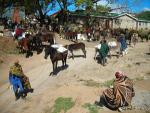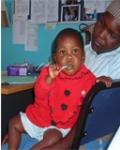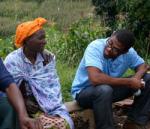Partners in Health Update (6/23/2008)
 There a number of new items on the Partners in Health Website worth looking at. Watch (or read) an interview with Paul Farmer and Amy Goodman of Democracy Now! Paul traces the history of Haiti, discusses how a country with agricultural roots came to be tremendously food insecure, and explains how social justice and public health reinforce each other. As he puts it, "We need a movement that’s not just run by people who are experts, but the citizenry. Be part of a movement to push forward social justice, and that will lead us on healthcare, as well."
There a number of new items on the Partners in Health Website worth looking at. Watch (or read) an interview with Paul Farmer and Amy Goodman of Democracy Now! Paul traces the history of Haiti, discusses how a country with agricultural roots came to be tremendously food insecure, and explains how social justice and public health reinforce each other. As he puts it, "We need a movement that’s not just run by people who are experts, but the citizenry. Be part of a movement to push forward social justice, and that will lead us on healthcare, as well."
 Another piece concerns footwear as a public health intervention. Crocs may be gaudy, but they are sturdy and it turns out that they are perfect for preventing tungiasis, an infestation of sand fleas which "causes pain, itching, swelling, open sores and, if left untreated, sepsis, tetanus or gangrene." It has been a recurring problem on the Central Plateau, especially for the poorest of the poor who walk barefoot more often than not. Partners in Health and the Haitian Ministry of Health recently secured 40,000 pairs of the shoes from Crocs Footwear. Generously, Crocs Footwear footed (pun intended) the bill for the shipping from the factory in China to Port au Prince.
Another piece concerns footwear as a public health intervention. Crocs may be gaudy, but they are sturdy and it turns out that they are perfect for preventing tungiasis, an infestation of sand fleas which "causes pain, itching, swelling, open sores and, if left untreated, sepsis, tetanus or gangrene." It has been a recurring problem on the Central Plateau, especially for the poorest of the poor who walk barefoot more often than not. Partners in Health and the Haitian Ministry of Health recently secured 40,000 pairs of the shoes from Crocs Footwear. Generously, Crocs Footwear footed (pun intended) the bill for the shipping from the factory in China to Port au Prince.
 Apparently the initiative was orchestrated by Kageno Worldwide. I am not familiar with their work but the announcement states that they are a non-profit dedicated to “transform[ing] communities suffering from inhumane poverty into places of opportunity and hope.” Brother's Brother, another nonprofit, took charge of getting the shoes onto the dock. PIH and the Ministry of Health assumed responsibility for distributing the shoes through mobile clinics.
Apparently the initiative was orchestrated by Kageno Worldwide. I am not familiar with their work but the announcement states that they are a non-profit dedicated to “transform[ing] communities suffering from inhumane poverty into places of opportunity and hope.” Brother's Brother, another nonprofit, took charge of getting the shoes onto the dock. PIH and the Ministry of Health assumed responsibility for distributing the shoes through mobile clinics.
 There is another good article by Joseph Rigadon, a Haitian physician who got his start in Thomonde but is now working with Partners in Health in Lesotho. Conditions in Lesotho reflect increasing food insecurity worldwide. It is estimated that 40 percent of children under five are stunted and 20 percent are underweight, which are respectively signs of chronic and acute undernourishment.
There is another good article by Joseph Rigadon, a Haitian physician who got his start in Thomonde but is now working with Partners in Health in Lesotho. Conditions in Lesotho reflect increasing food insecurity worldwide. It is estimated that 40 percent of children under five are stunted and 20 percent are underweight, which are respectively signs of chronic and acute undernourishment.
 Even before the recent upsurge of hunger in Lesotho and around the world, the article states that PIH-Lesotho teamed up with the World Food Program to provide monthly food rations to all tuberculosis and HIV patients. Optimal prevention and treatment of HIV are impossible without adequate nutrition. Without adequate nutrition, HIV patients are more likely to contract severe illnesses due to the weakness of their immune systems. I can't resist repeating the Haitain proverb here, but providing someone medicines and not food is like "washing your hands and then wiping them in the dirt" (lave men, siye te.)
Even before the recent upsurge of hunger in Lesotho and around the world, the article states that PIH-Lesotho teamed up with the World Food Program to provide monthly food rations to all tuberculosis and HIV patients. Optimal prevention and treatment of HIV are impossible without adequate nutrition. Without adequate nutrition, HIV patients are more likely to contract severe illnesses due to the weakness of their immune systems. I can't resist repeating the Haitain proverb here, but providing someone medicines and not food is like "washing your hands and then wiping them in the dirt" (lave men, siye te.)
 Jonas writes that when severe malnutrition, the kind which is life threatening, shot up last year PIH launched a supplementary feeding program to provide nutritional support to all malnourished children in the mountains. Every child enrolled in the program receives a set package of nutrition foods. All severely or moderately malnourished children older than six months received special high-protein, high-energy peanut butter fortified with vitamins and sugar. You can read more about Plumpynut here. Jonas points out the other benefits of these regular visits which provide opportunities for life saving vaccinations, testing parents and children for HIV, distributing vitamin A to boost young immune systems, and iron supplements to fight amenia.
Jonas writes that when severe malnutrition, the kind which is life threatening, shot up last year PIH launched a supplementary feeding program to provide nutritional support to all malnourished children in the mountains. Every child enrolled in the program receives a set package of nutrition foods. All severely or moderately malnourished children older than six months received special high-protein, high-energy peanut butter fortified with vitamins and sugar. You can read more about Plumpynut here. Jonas points out the other benefits of these regular visits which provide opportunities for life saving vaccinations, testing parents and children for HIV, distributing vitamin A to boost young immune systems, and iron supplements to fight amenia.
 Peter Drobac then writes about how PIH's experiences in Haiti prepared the organization well for working in Rwanda. It has now been three years since PIH teamed up with the Clinton Foundation and the Rwandan government to rebuild health systems in Kayonza (Rwinkwavu) and Kirehe. Two hospitals, seven health centers, and scores of community health workers have facilitated access to care where none existed before. This includes antiretroviral therapy for more than 2,000 HIV infected individuals. Jobs caring for the communities have also been created, many taken by recovering patients. Who is more dedicated than someone who has lived through or is living with TB or HIV/AIDS?
Peter Drobac then writes about how PIH's experiences in Haiti prepared the organization well for working in Rwanda. It has now been three years since PIH teamed up with the Clinton Foundation and the Rwandan government to rebuild health systems in Kayonza (Rwinkwavu) and Kirehe. Two hospitals, seven health centers, and scores of community health workers have facilitated access to care where none existed before. This includes antiretroviral therapy for more than 2,000 HIV infected individuals. Jobs caring for the communities have also been created, many taken by recovering patients. Who is more dedicated than someone who has lived through or is living with TB or HIV/AIDS?
 The model has proven so successful, the Government of Rwanda is seeking to apply it countrywide. It can be done but will require years of hard work, partnerships with NGOs, faith based groups, international organizations, community organizations, and of course, increased funding. My favorite part of this article concerns Patrick Almazor, a young Haitian physician from Port au Prince. Patrick's experiences working in low resource settings on the Central Plateau of Haiti prepared him well for expanding services into districts such as Burera where none existed. Patrick is now the Burera District Director. Haiti has drawn much from Africa. Jonas and Patrick are excellent examples of Haitians giving back.
The model has proven so successful, the Government of Rwanda is seeking to apply it countrywide. It can be done but will require years of hard work, partnerships with NGOs, faith based groups, international organizations, community organizations, and of course, increased funding. My favorite part of this article concerns Patrick Almazor, a young Haitian physician from Port au Prince. Patrick's experiences working in low resource settings on the Central Plateau of Haiti prepared him well for expanding services into districts such as Burera where none existed. Patrick is now the Burera District Director. Haiti has drawn much from Africa. Jonas and Patrick are excellent examples of Haitians giving back.
 The Partners in Health Model Online is definitely worth a look as well. Their rights based approach to public health has proven itself again and again. The PIH Model Online Section is an excellent resource and provides numerous resources without charge. You can also sign up for regular PIH bulletins by clicking here.
The Partners in Health Model Online is definitely worth a look as well. Their rights based approach to public health has proven itself again and again. The PIH Model Online Section is an excellent resource and provides numerous resources without charge. You can also sign up for regular PIH bulletins by clicking here.
If their work resonates you, we hope you will consider buying one of their calendars, making a donation, or just spreading the word. PIH continues to make the world more just one patient at a time.
Bryan
Add new comment